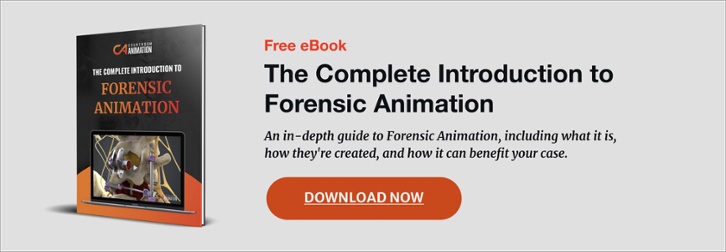According to the American Judges Association, as much as 97% of civil cases are settled outside of the courtroom. But what happens when your case falls in the other 3% and is complex? When it’s up to a judge or jury to hear the facts of the case and determine liability, it’s time to put some thought into how you can present your case.
Regardless of which side of the case you’re on, demonstrative evidence is the key to making or breaking your case – even in mediation!
Our Demonstrative Animation That Went Viral in 2015
We understand that there are so many factors that go into creating and using demonstrative evidence in court and during mediation discussions. That’s why we have compiled this clickable table of contents of articles to help you learn more about the advantages of demonstrative exhibits, like forensic animation:
- What is demonstrative evidence?
- What is the difference between real and demonstrative evidence?
- Does demonstrative evidence have different or new legal admissibility standards?
- What are the most impactful demonstrative evidence examples?
- Is litigation animation demonstrative or real evidence?
- What demonstrative exhibit techniques are used by civil attorneys?
- How can I tell a better story with a trial graphics presentation?
- Does my case need demonstrative exhibits?
- What high-profile cases have used evidence animation?
- What does effective demonstrative evidence at trial look like?
- How do plaintiff & defense attorneys use trial demonstratives?
- How can I effectively introduce demonstrative evidence to the jury?
- What’s the ROI of demonstrative evidence in court & mediation?
Demonstrative evidence supports your case in every stage of litigation, but how much will it affect your budget?
Download our free pricing guide to discover:
- 3 major contributing factors to the cost of an animation
- The approximate costs of 7 types of visual
- A guide to the bidding process & production schedule
- And more!
1. What is demonstrative evidence?
Demonstrative evidence is any visual or device that is used during litigation to bolster an attorney’s, or expert’s, position or argument.
Legal teams presenting their cases to a jury often rely on expert testimony to bolster the credibility of certain facts or statements. While this expert insight is important, it rarely stands alone.

Sample Legal Visual From Courtroom Animation
One study found that jurors could only recall about 10% of verbal information shared through jargon-filled witness testimony. However, they were able to retain 87% of the additional information shared through visual aids like demonstrative evidence.
Demonstrative evidence includes:
- 3D Models
- 3D or 2D Diagrams
- Photographs
- Animations
- Video Analysis
- Accident Reconstruction
- Maps
- Timelines
- Legal Graphics
- Medical Animations
- And more!
Demonstrative evidence provides a visual method that gets attention from a jury, simplifying the facts and promoting better retention of the facts as they’re presented in court. This type of evidence can be a powerful way to relate to jurors that are likely to get lost in technical jargon during expert testimony.
Learn more about how visuals enhance a civil attorney’s credibility and more in this article, “What is Demonstrative Evidence?”
2. What is the difference between real and demonstrative evidence?
How is demonstrative evidence different from other types of admissible evidence?
Demonstrative evidence is a broad definition term that includes any artifact or depiction of factual information. These items typically include things like charts, models, videos and photographs that help share facts in a visual format.
Real evidence, by contrast, is generally limited to tangible objects. For example, in a medical case, real evidence might include x-ray images taken of injuries. In that same case, demonstrative evidence might include a doctor describing injuries using an anatomical model.
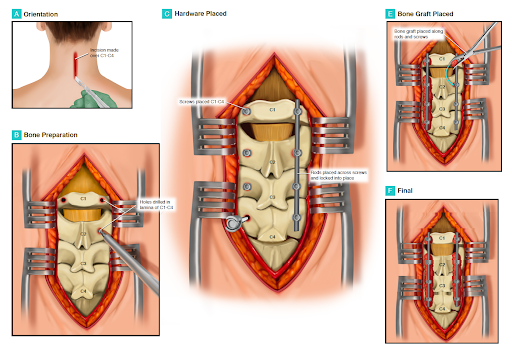
Same 2D Medical Graphic from Courtroom Animation
There are similarities between the two–and sometimes the lines get blurry. For example, a photograph of injuries can be classified as both real and demonstrative evidence. The photographs themselves are demonstrative, but the injuries depicted in the subject of the photography are real.
Demonstrative evidence, like trial graphics, have a high impact on juror retention and high admissibility based on factual representation. Hopefully this answers your question of, “What is the difference between real and demonstrative evidence?”
Next, let’s take a closer look at the legal admissibility of demonstrative evidence.
3. Does demonstrative evidence have different or new legal admissibility standards?
Demonstrative evidence, in general, has a high admissibility rate because it’s based on facts. But that doesn’t mean that all types of demonstrative visuals are equal. In some cases, a judge might not allow demonstratives either because it is technically hearsay or because it has not been properly authenticated.
With those two limitations in mind, visual evidence makes a big impact on a jury. It can be a worthwhile investment to consult experts and create a compelling visual aid that reinforces your witness testimony.

Car Crash Animation Still From Courtroom Animation
The Federal Rules of Evidence adopted in 1975 still serve as the basis for legal admissibility. These rules indicate that demonstrative evidence should be:
- Found to contain voluminous summarized information.
- Found to represent an accurate compilation of factual data.
- Found to contain facts or information that is otherwise independently admissible.
- Made available to opposing counsel for independent review, including underlying sources.
Learn more about the legal admissibility of demonstratives in this article: 5 Questions About the Legal Admissibility of Demonstrative Evidence, Answered.
Now, let’s take a look at some demonstrative evidence examples used in real cases.
4. What are the most impactful demonstrative evidence examples?
Visual litigation aids can take many forms, including animations, diagrams, and illustrations. These visuals help the jury understand the role of human cause and effect within a scenario.
It’s a relational learning tactic that helps jurors distinguish who is liable for damages and ultimately come to an outcome decision in a case.
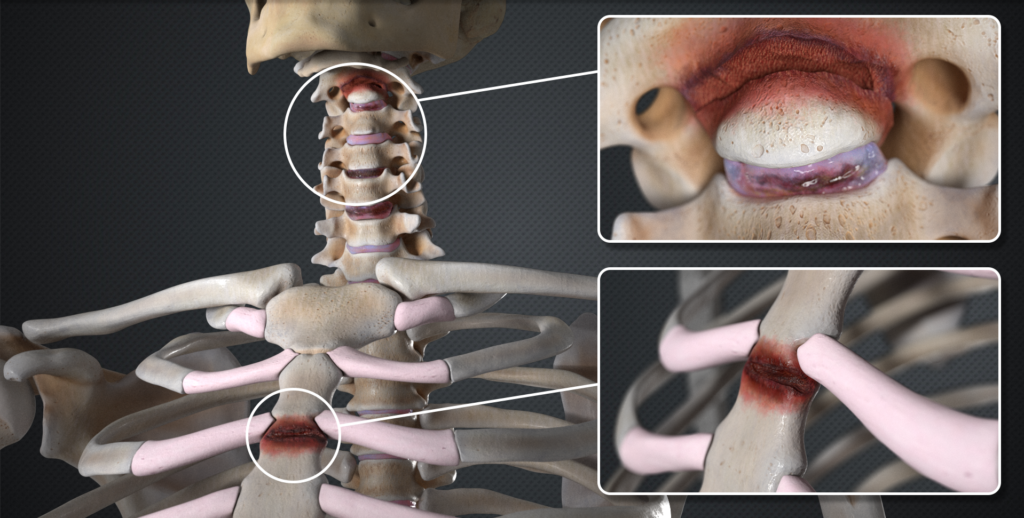
Sample Medical Demonstrative Evidence Example From Courtroom Animation
For example, medical animations, graphics, and diagrams can help illustrate expert doctor testimony by showing jurors how injuries might impact normal movement. In a medical malpractice case, this evidence can be integral to understanding how someone’s life has been impacted by a neglectful procedure.
Other demonstrative evidence examples include:
- Right way, wrong way animations for traffic accidents
- Mechanism of injury graphics to show fault for the cause of an injury
- Product failure animations for defects
- Forensic animations
- Video analysis from surveillance footage
Collectively, demonstrative exhibits provide a fact-based visual representation that helps jurors understand and retain the information presented. In meditation, these legal graphics or visuals are used to show how prepared you are to go to trial, and to prompt the opposing counsel to reconsider their case.
So, how does litigation animation fit into the demonstrative visual category?
5. Is litigation animation demonstrative or real evidence?
Litigation animation is a broad term for an animated data visualization used in litigation. It can help connect physical evidence and deposition, then testimony in a way that your audience can understand and retain. It’s not a replacement for strong evidence; it’s a tool to make sure that the facts are well understood before a jury deliberates. Visual aids like litigation animation can help support a case argument by catering to all the ways that human jurors perceive information. According to studies based on the Wechsler Memory Scale, shows that jurors are more likely to retain visual information.
A litigation graphic can help convey facts when arguing fault in a collision case, personal injury claim, construction defect, or medical malpractice.
For defense attorneys, these animations can help disprove or prove negligence, emphasize the facts of the case, and create a lasting impression on the jury.
For plaintiff attorneys, these animations can create empathy for their client’s pain and suffering, depict negligence, and create a memorable story that resonates with the jury.
6. What demonstrative exhibit techniques are used by civil attorneys?
There’s no substitute for a strong case. However, accurate trial exhibits can help facilitate a favorable outcome by ensuring that the members of the jury hear, understand, and remember the facts of your case.
Civil lawyers employ many different demonstrative exhibit techniques to achieve their desired outcomes, including the ability to find an engaging way to present facts.
Civil lawyers often turn to storytelling, a form of emotionally-bound communication that humans are familiar with. In fact, it’s one of the best ways to circumvent personal bias and snap judgments.
“To become better storytellers, lawyers need to leave the insulated world of legal practitioners and study what makes other professional storytellers effective.”
– Chris Arledge, Advocacy Instructor and Managing Partner at Ellis George Cipollone O’Brien Annaguey LLP
In the courtroom, these stories provide a format to tie evidence and testimony together. They’re designed to make an emotional connection, leaving a lasting impression during closing arguments. And they envelop an illustrative narrative that can pull attention away from opposing counsel.
For attorneys with cases in mediation or heading for trial, it’s important to utilize every tool in your arsenal to tell a compelling narrative.
7. How can I tell a better story with a trial graphics presentation?
Another demonstrative exhibit technique to telling an effective story in the courtroom is to create a bridge between the facts of the case and contextual clues. This wraps the whole case and your argument into an engaging story format.
A good trial graphics presentation format includes communicating the details like character development for a protagonist and antagonist, setting the scene, and walking the audience through the plot to achieve a resolution. It’s a journey that’s rooted in factual information, that engages an emotional connection.
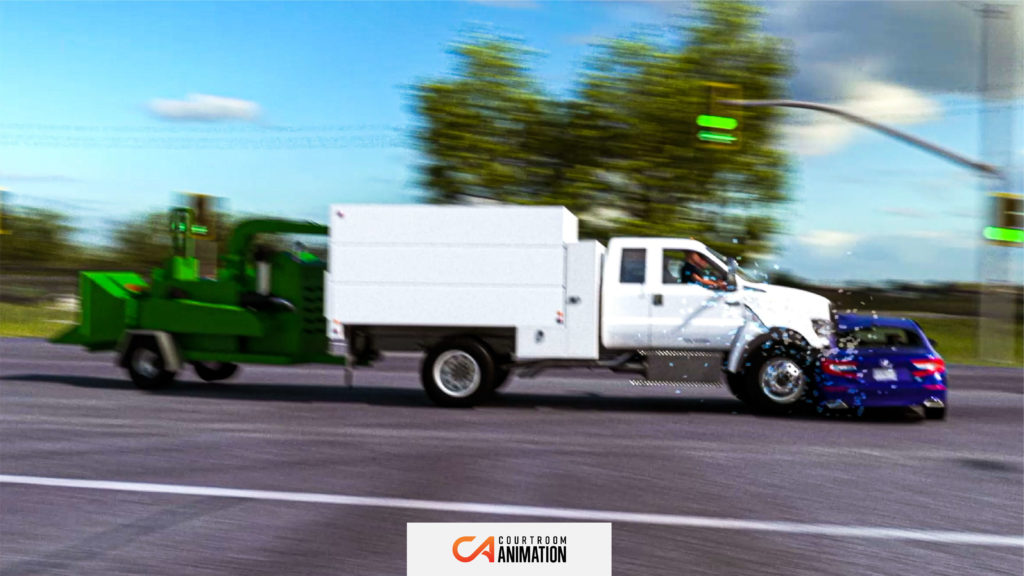
Motor Vehicle Collision Animation Still From Courtroom Animation
A strong trial graphics presentation amplifies your messaging in the narrative. Words are easily forgotten and meaning is often misunderstood. However, a trial graphic can help the visual-spatial recognition that is necessary to learn new information and retain important facts.
It’s no surprise that most people (and thus, jurors) all want to be visually engaged due to modern media-savviness. In many cases, jurors in a modern courtroom expect trial graphic presentations.
Providing information in a familiar format that is easy to digest leads to more favorable outcomes for civil attorneys. But what types of cases benefit from trial demonstratives?
8. Does my case need demonstrative exhibits?
Demonstrative exhibits provide a powerful visual aid for complex topics.
Any situation where expert testimony involves the heavy use of unfamiliar terminology or detailed explanations of scenario-based events, demonstrative exhibits can help simplify the communicated message for the jury.
Consider how everyday individuals might perceive testimony from a medical doctor. The doctor will refer to locations on the body using anatomical terminology that is uncommon in everyday language. While your jury is trying to interpret what the doctor is saying, they’re missing valuable details that support your argument.
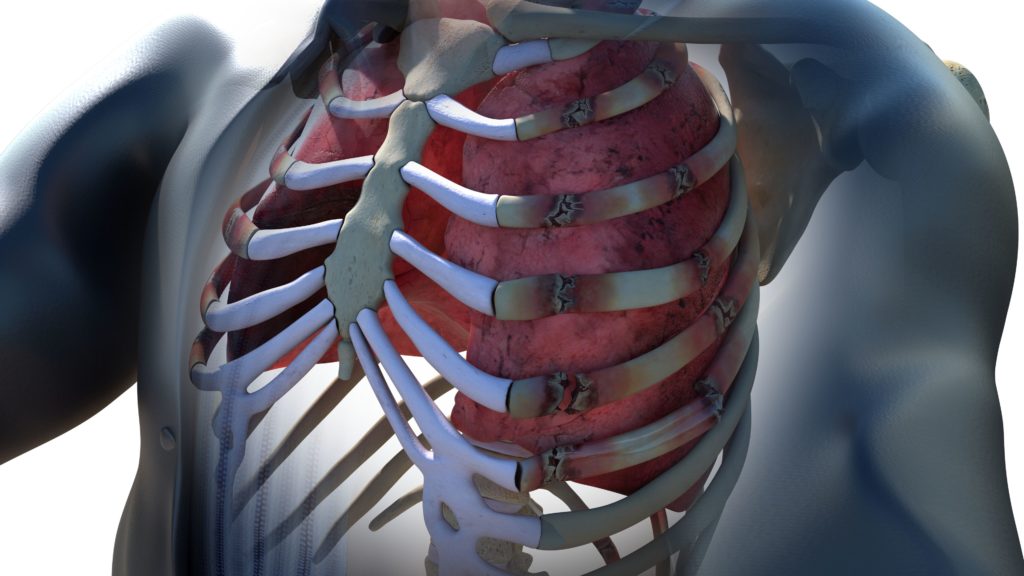
Demonstrative Evidence Example From Courtroom Animation
Demonstrative exhibits can provide visual support showing jurors where or how injuries occurred based on the doctor’s expert testimony. With these visuals, jurors spend less time trying to comprehend jargon-filled explanations and more time considering the facts of the case.
These visuals can be a great way to share:
- Complex Data
- Conflicting Testimony
- Technical Concepts
- Representations of Movements
If you’re interested in how high-profile civil cases have used demonstrative evidence examples in their trials, continue reading.
9. What high-profile cases have used evidence animation?
Evidence animations are a type of demonstrative visuals with widespread use in civil courtrooms. In recent history, we’ve seen these animations in the Depp v. Heard trial, a high-profile Hollywood defamation suit. And, again, in the Caitlyn Jenner car crash case, as well as Kyle Rittenhouse’s domestic terrorism trial.
That’s just the beginning. Litigation animations have been around for a few decades. In 1985, Delta Flight 191 crashed into a Texas airport. Following massive casualties and property damage, the civil case against the Federal Aviation Administration and the National Weather Service ensued.
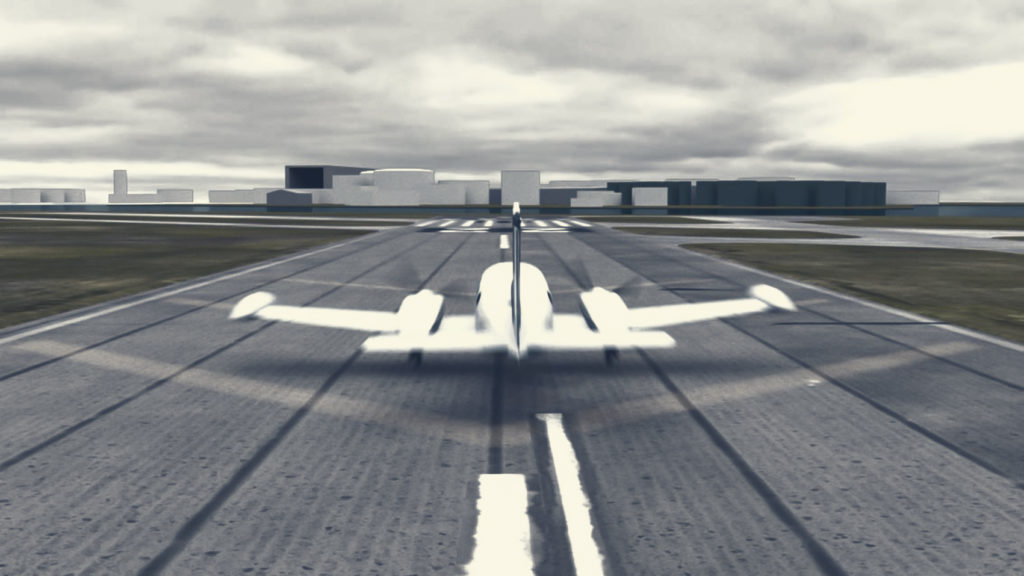
Aviation Animation Still from Courtroom Animation
In this case, aviation animations helped absolve the two defendants by helping the jury understand the circumstances surrounding the airplane crash and the complexity of factors involved.
More recently, in 2020, the officer-involved shooting death of Jacob Blake gained national news attention. During a tense, high-stakes trial with strong emotions on both sides, court exhibits helped present an unbiased version of factual events to the jury.
Next, we’ll talk about how to ensure your case’s demonstrative exhibits are effective.
10. What does effective demonstrative evidence at trial look like?
The point of demonstrative exhibits is to simplify communication. In order to be effective, the exhibit needs to be able to put complex technical concepts into simplified explanations or to find a common unifying theme across multiple viewpoints.
Learn how one attorney landed a $44 million verdict with vivid demonstrative evidence at trial!
Demonstrative presentations tend to be highly effective because they present a moving 2D or 3D visual that helps simplify complex language. If an expert is using technical jargon, an animation can label the item or area being discussed.
In a product failure case, the plaintiff attorney coordinated with an experienced forensic animation team to create a demonstrative exhibit that walked jurors through the normal operation of a hydraulic press. It represented internal mechanisms that are not otherwise visible and pinpointed the points of failure.
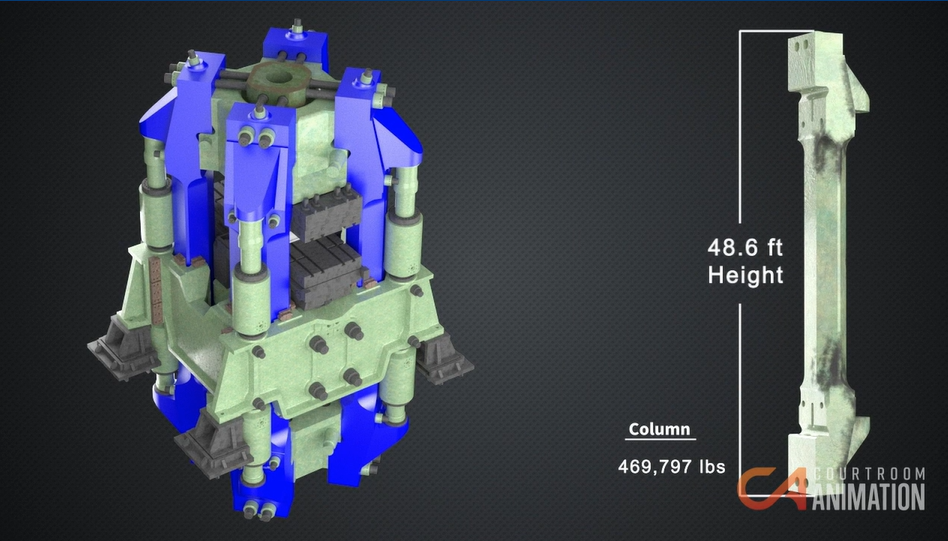
Product Failure Demonstrative Visual From Courtroom Animation
As a result of preparing an effective demonstrative exhibit, the plaintiff was awarded a $44M settlement. The key to creating an effective exhibit is to invest time into understanding the differences between normal operation and what occurred in the named event.
11. How do plaintiff & defense attorneys use trial demonstratives?
Trial demonstratives are factual representations that can support testimony on either side of a case.
- For plaintiff attorneys, these exhibits can help a jury understand the impact of an incident or the extent of suffering, leading to larger settlement awards.
- For defense attorneys, trial animations can articulate factual information illustrating a series of events and the defendant’s relative actions.
The key to creating admissible demonstrative evidence is to stick to the facts. In one case, a police officer was being sued by the relatives of deceased passengers in a high-speed broadside collision. The plaintiff’s attorney argued that the officer was negligent for traveling through a red light intersection at 57mph, resulting in the accident.
A demonstrative evidence exhibit illustrated the series of events between the two vehicles, indicating that the officer was following protocol with appropriate lights and sirens before proceeding into a clear intersection.
After the plaintiff counsel presented their trial demonstratives, the jury gave a verdict of $8 Million.
If you are considering visuals for one of your cases, or you simply want to be prepared for when the other party uses an animation, look no further.
Download our free guide, “The Complete Introduction to Forensic Animation,” to discover:
- How legal animations and litigation graphics are created
- Which practice areas and civil cases can benefit the most
- Why over 1800+ cases have featured visuals
- And more!
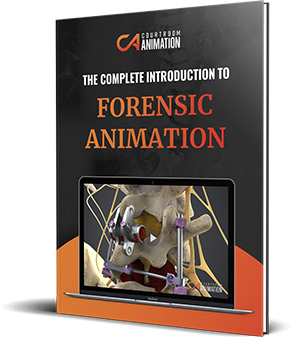
This factual representation of the accident removed emotion from the equation and allowed jurors to see that the car that entered the intersection was at fault, absolving the officer of the wrongful death and negligence suit.
12. How can I effectively introduce demonstrative evidence to the jury?
A good piece of demonstrative evidence can make a case, but only if it’s accepted into the court. While this type of evidence has a high admissibility rate, it’s not guaranteed. The first step in introducing demonstrative evidence to the jury starts before you step into the courtroom. The aim is to show the evidence to a pre-trial focus group.
The focus group is a mock jury that will shed insightful perspective on the impact your exhibit will make before your case goes to trial. Here, you’ll learn if your exhibit is truly unbiased and representative of the facts – the minimum requirement for legal admissibility.
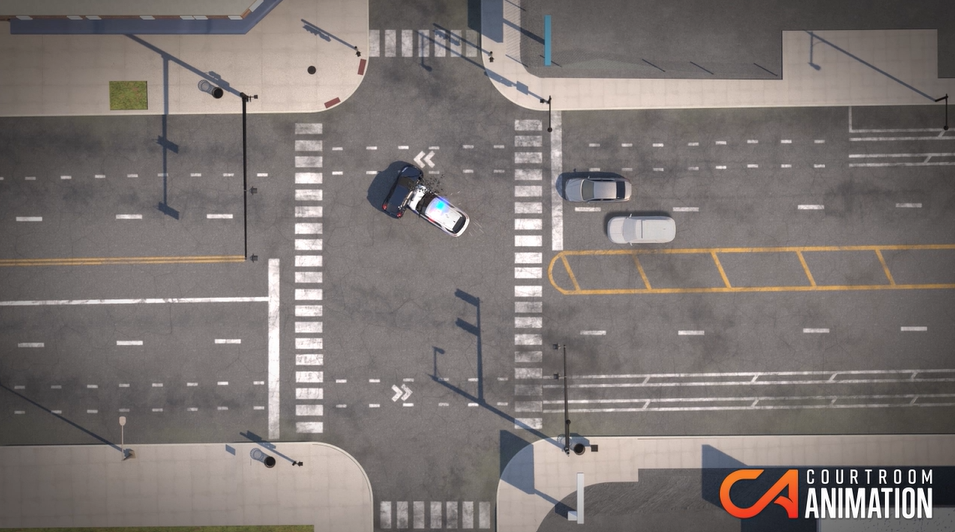
Police Vehicle Car Crash Exhibit Example from Courtroom Animation
Once you get the evidence animation or graphic into the courtroom, introduce it early – possibly even in your opening statement. It’s a good idea to maximize the jury’s exposure to the visual information to further promote retention.
Remind the jury of the evidence during supporting expert testimonies and again in closing statements.
Demonstrative evidence can be a powerful tool, it all depends on how you utilize it. Learn more about how to time your presentation in this article: How to Introduce Demonstrative Evidence to the Jury.
Next, we’ll talk about what to expect in terms of cost and return on investment when working with a legal graphic services company.
13. What’s the ROI of demonstrative evidence in court & mediation?
Preparing effective, high-quality demonstrative exhibits takes time and money – but they don’t have to break the bank. The potential to win your case and receive a higher settlement value makes a compelling argument for the investment.
In one instance, our team provided an accident reconstruction animation that led to a $1M settlement – an $500,000 increase in their original settlement offer! This value was 20x ROI for the investment of just one legal animation.
The calculation for evaluating the return on investment for any exhibit, expert, or other legal service would be:
ROI Equation:
Increased Verdict or Settlement Amount / Cost of Investment x 100%
Learn more about the ROI of trial exhibits in this article: “The ROI of Demonstrative Evidence in Court & Mediation.”
When the facts of a case are complex, there’s a lot at stake. A quality demonstrative exhibit is the best way to keep things simple and ensure the right message gets across.In many cases, compelling demonstrative exhibits can help in and out of the courtroom, including higher settlement offers. “Once the visuals were completed and viewed by both parties, the defense counsel raised their offer to $1 million.”
“The forensic animations were a game-changer that helped us receive a $1 million dollar settlement. Courtroom Animation’s team also worked within our tight deadline to deliver them within a two-week period!”
– Brad Wallace, Attorney & Founder of The Wallace Law Firm
Consider the complexity of presenting coordinating facts from an accident reconstruction, a forensic meteorologist, a human factors specialist, and environmental science to explain the facts of a case to a jury of non-technical peers without special training or expertise in these areas.
In those instances, demonstrative evidence can be invaluable.
How much do demonstrative exhibits cost?
There are truly demonstratives for every budget. And as explained earlier, your audience has been exposed to visuals in today’s modern era, and has an inherent bias toward expecting them. Attorneys can meet this expectation with a visual that fits their case’s narrative. Mediation graphics or medical illustration services can be created without breaking the bank.

Sample Pricing Chart from Courtroom Animation’s Forensic Animation Pricing Guide.
Download your free PDF for more information.
Legal Graphics & Animations are the Key to Receiving a Favorable Verdict or Settlement
Regardless of which side of the case you’re on – the facts can be presented in a variety of ways. Some methods are more effective than others, but demonstratives have almost always triumphed over solely oral explanations. Expert testimony or deposition adds credibility, but is easily misunderstood and quickly forgotten by most jurors or mediators.
Learn more about how major events have leveraged forensic animation from our CEO, Brady Held, at Fireside Forensics.
Real evidence can be hard to ignore, but is not well understood without appropriate context. Legal graphics help bridge the gaps between the two – providing factual context and illustration, helping jurors understand the information as it is presented.
From creating effective demonstrative exhibits to understanding when, why, and how to use them; Courtroom Animation can help you build a strong foundation for your next civil case.
